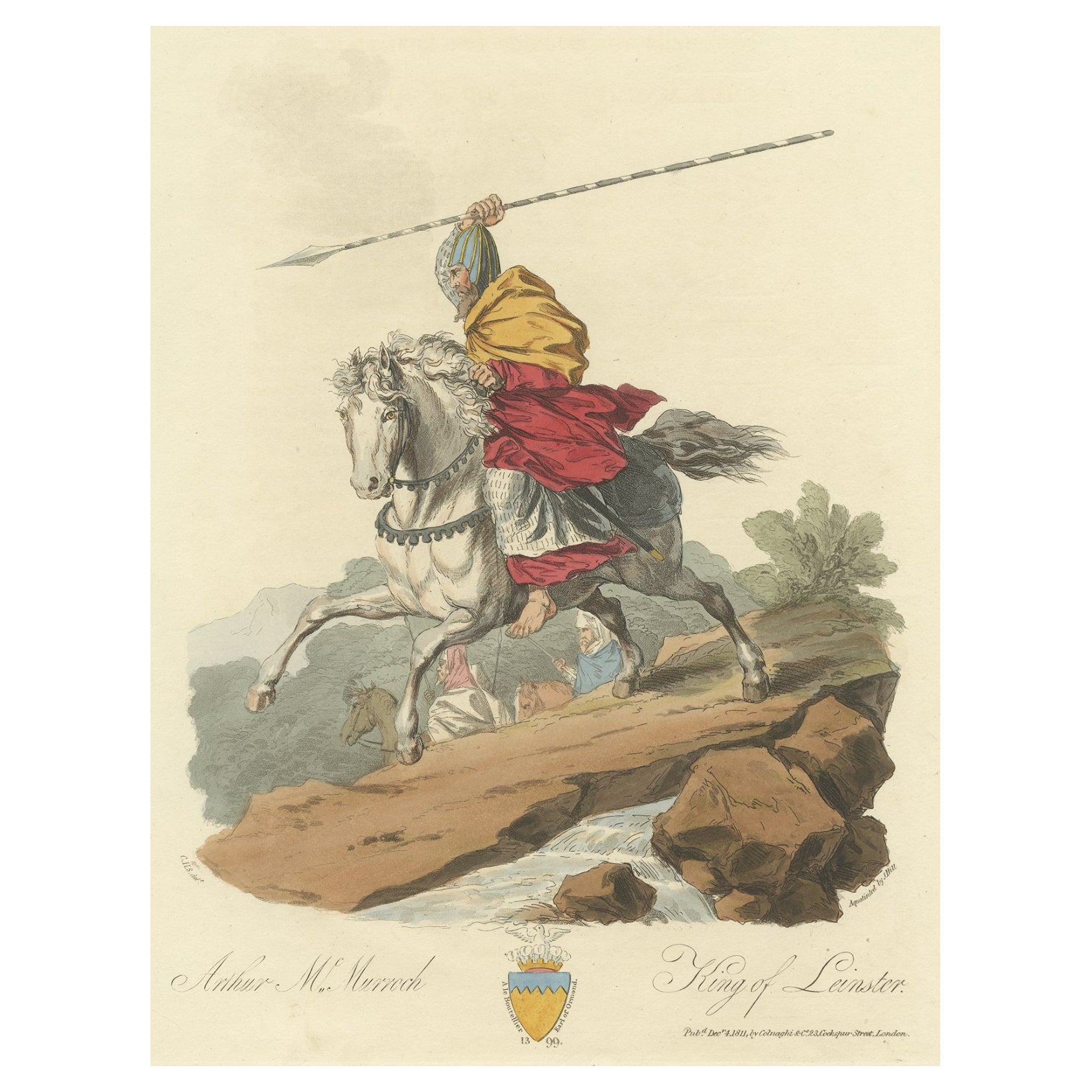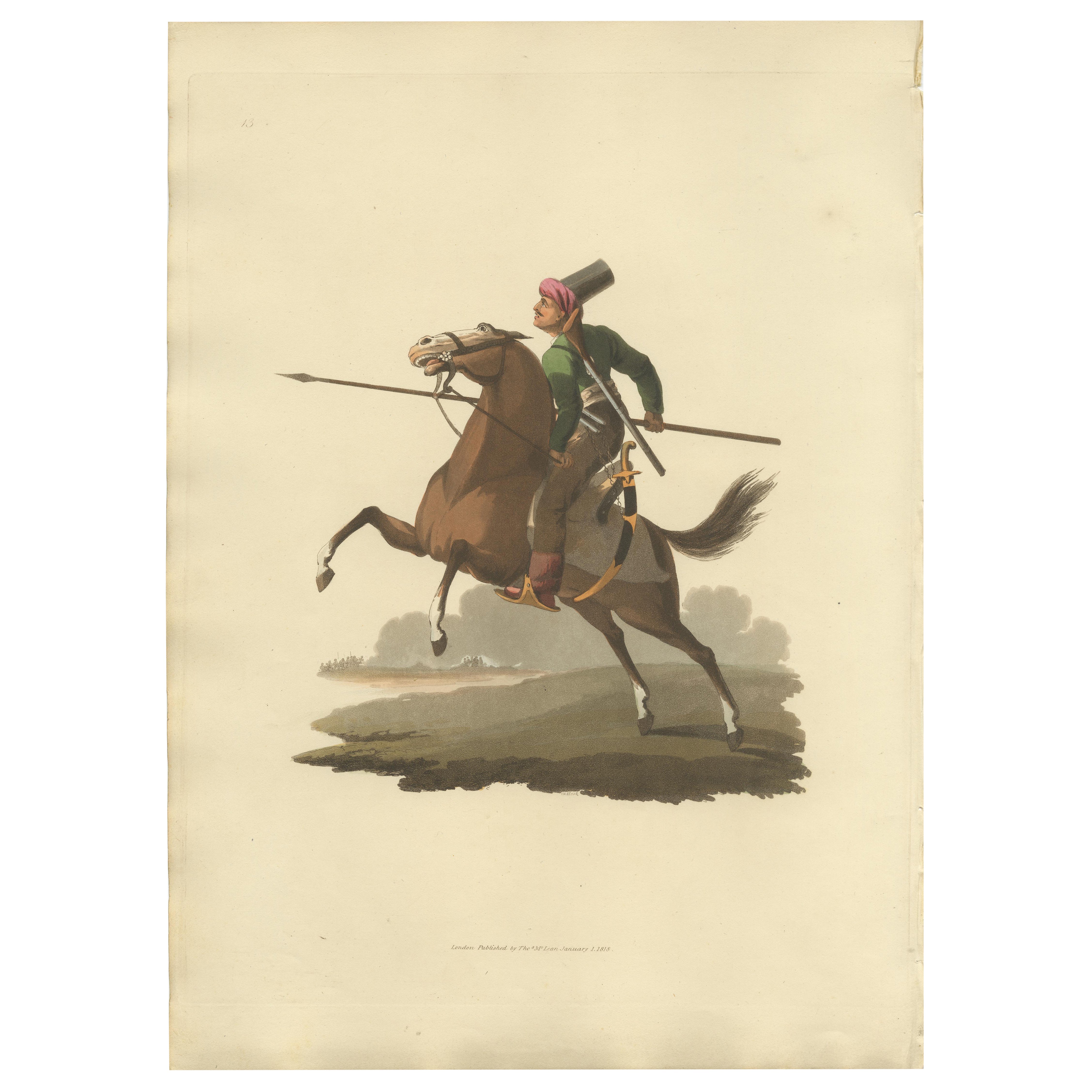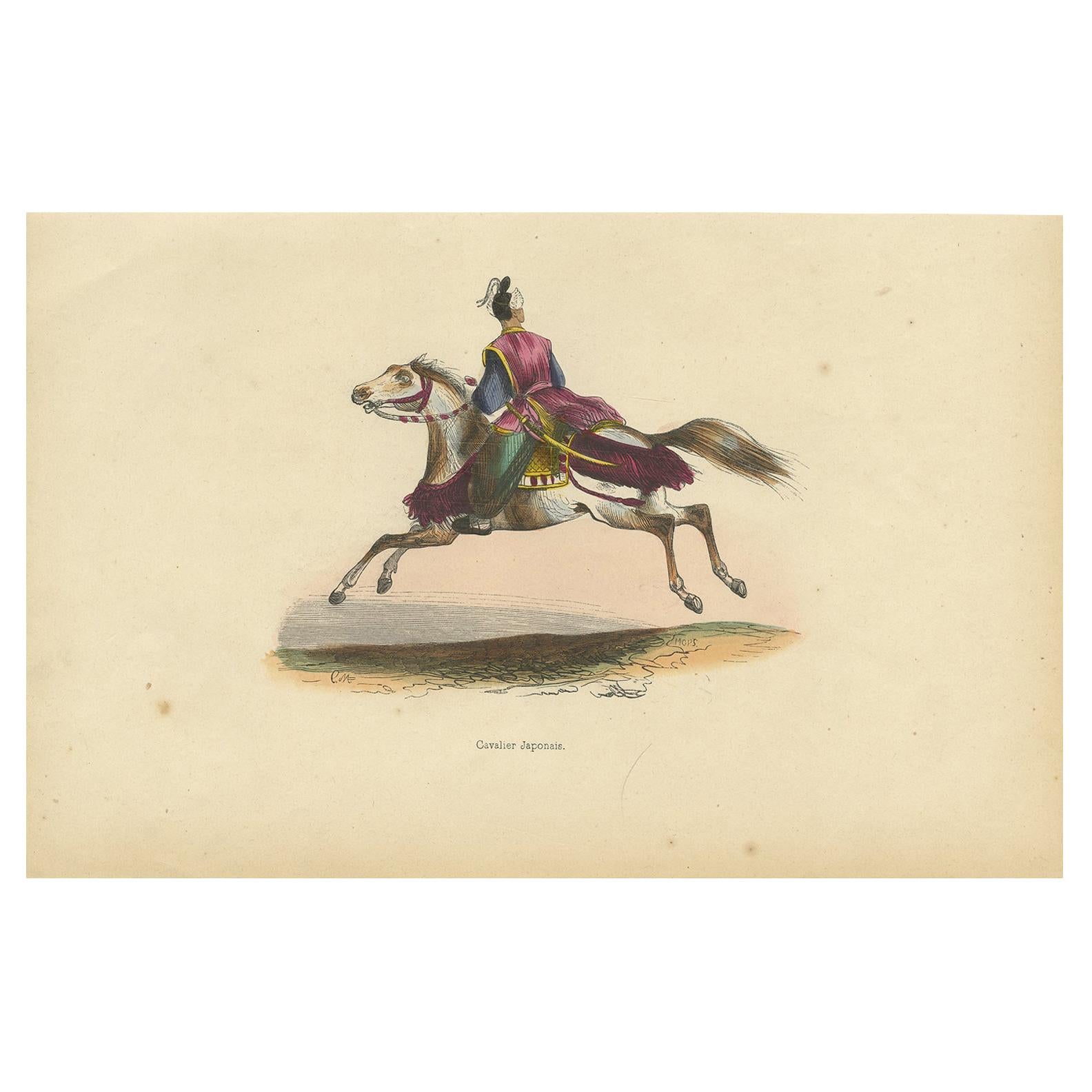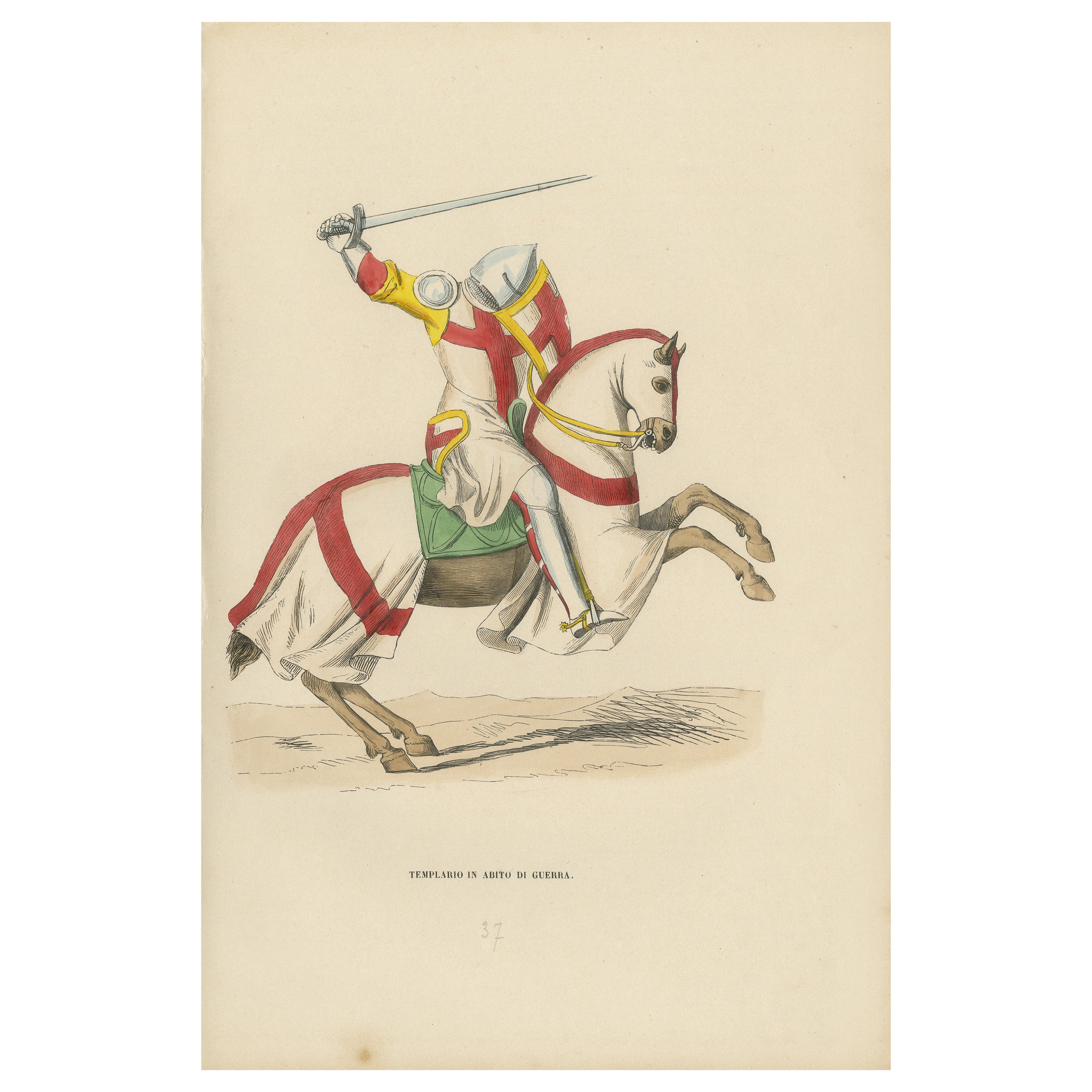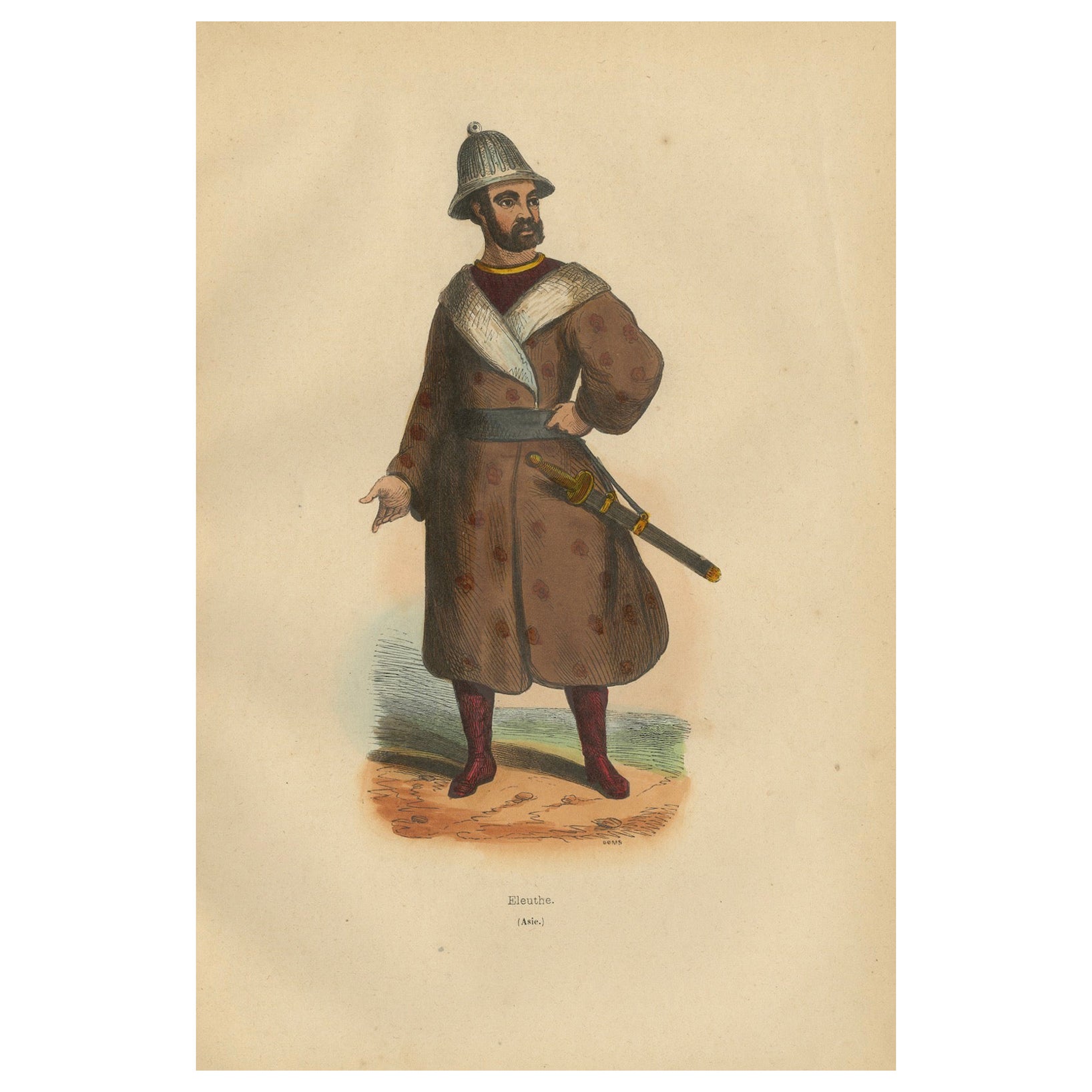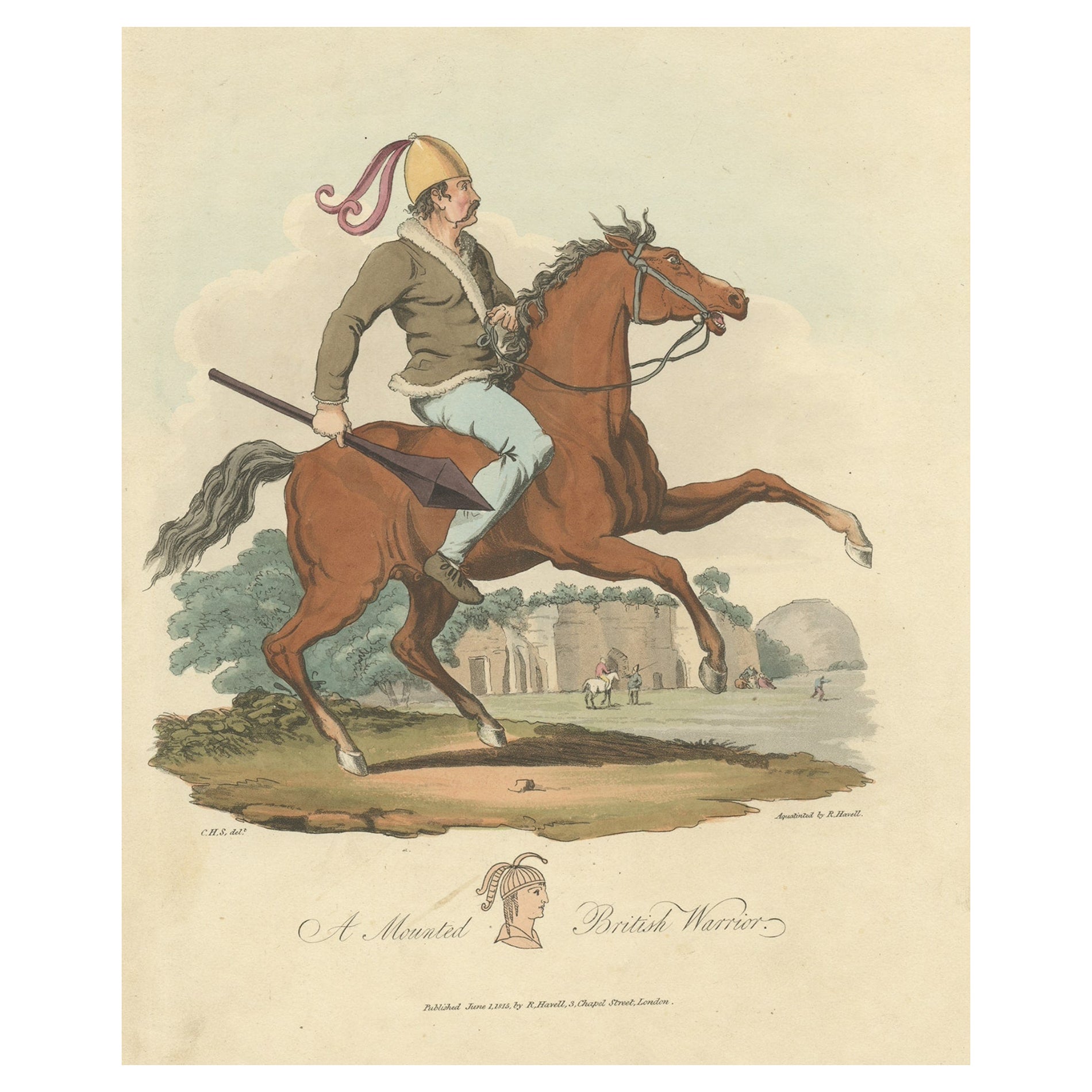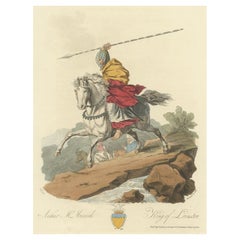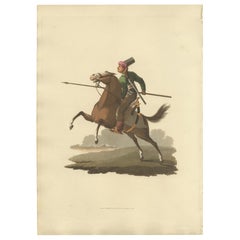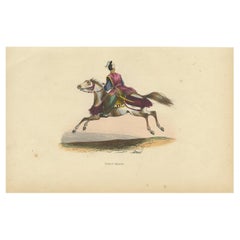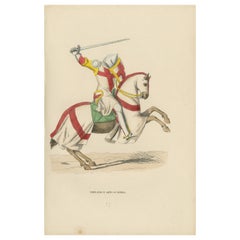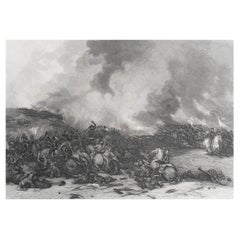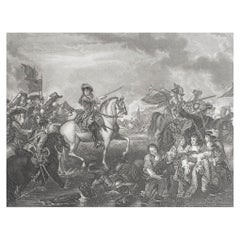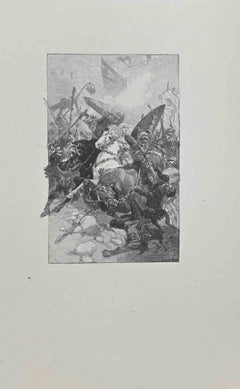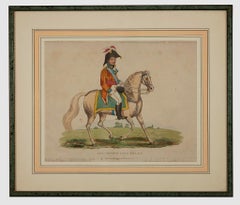Items Similar to Arthur MacMurrough: The Irish Charging Chieftain, Lithograph Published in 1847
Want more images or videos?
Request additional images or videos from the seller
1 of 6
Arthur MacMurrough: The Irish Charging Chieftain, Lithograph Published in 1847
$180.28
$225.3520% Off
£135.33
£169.1620% Off
€152
€19020% Off
CA$252.21
CA$315.2620% Off
A$276.04
A$345.0420% Off
CHF 143.48
CHF 179.3620% Off
MX$3,322.18
MX$4,152.7320% Off
NOK 1,803.83
NOK 2,254.7820% Off
SEK 1,692.05
SEK 2,115.0620% Off
DKK 1,158.05
DKK 1,447.5620% Off
About the Item
This print appears to portray a figure named Arthur MacMurrough, a historical or legendary figure associated with medieval Ireland. The warrior is mounted on a spirited white horse, which is captured in mid-gallop, its mane and tail flowing with the movement. The rider is attired in vibrant and contrasting colors, with a yellow cloak billowing behind him and a pink tunic covering a chainmail armor, which peeks through in areas, suggesting readiness for battle.
He wears a blue and yellow striped turban on his head, which gives him an exotic and noble appearance, perhaps indicating status or a role of leadership. The warrior holds a long spear in his right hand, raised high above his head in a gesture that could be interpreted as either a call to arms or a victorious salute.
The minimalistic landscape in the background, with its gentle dunes, emphasizes the figure’s prominence and the dramatic action of the scene. The image captures a moment of dynamism and seems to convey a narrative of leadership, bravery, and the martial spirit of the age.
More about the vivid colors of this original hand-colored antique print:
The colors have a nice glow over them. Historically, egg whites, known as glair, and sometimes egg yolk were indeed used in illumination and painting, particularly in manuscripts, to give colors a brighter appearance and to add a sheen or gloss to the work. This technique was quite common during the Middle Ages and into the Renaissance.
Egg whites can be applied as a varnish over pigments to enhance their brightness and to protect the colors. This application could make the colors appear more vivid and also add a slight glossy sheen to the surface of the image.
Egg yolk, on the other hand, was commonly used as a binding agent in paint. It forms the basis of tempera paint, a medium that was widely used before the advent of oil painting. Egg yolk helps to create a durable and long-lasting color that adheres well to various surfaces.
In the context of the print from 1847, it's less likely that egg whites or yolks were used directly on the print, as by that time, commercial printing processes would have been more advanced and less reliant on such manual methods. However, if this print is a representation of an earlier style or is meant to mimic the appearance of hand-painted manuscripts, the original artists might have employed techniques or materials that gave a similar effect to those achieved with egg-based binders and varnishes.
- Dimensions:Height: 10.63 in (27 cm)Width: 7.09 in (18 cm)Depth: 0 in (0.02 mm)
- Materials and Techniques:
- Period:
- Date of Manufacture:1847
- Condition:Good. Overal very light toning and light soiling but the image itself clean and hand-colored almost 200 years ago and still in expliciet colors. Aged paper with typically warm, yellowish-brown hue, mostly around the edges. One small brown spot.
- Seller Location:Langweer, NL
- Reference Number:Seller: BG-13635-401stDibs: LU3054337889312
About the Seller
5.0
Recognized Seller
These prestigious sellers are industry leaders and represent the highest echelon for item quality and design.
Platinum Seller
Premium sellers with a 4.7+ rating and 24-hour response times
Established in 2009
1stDibs seller since 2017
2,688 sales on 1stDibs
Typical response time: <1 hour
- ShippingRetrieving quote...Shipping from: Langweer, Netherlands
- Return Policy
Authenticity Guarantee
In the unlikely event there’s an issue with an item’s authenticity, contact us within 1 year for a full refund. DetailsMoney-Back Guarantee
If your item is not as described, is damaged in transit, or does not arrive, contact us within 7 days for a full refund. Details24-Hour Cancellation
You have a 24-hour grace period in which to reconsider your purchase, with no questions asked.Vetted Professional Sellers
Our world-class sellers must adhere to strict standards for service and quality, maintaining the integrity of our listings.Price-Match Guarantee
If you find that a seller listed the same item for a lower price elsewhere, we’ll match it.Trusted Global Delivery
Our best-in-class carrier network provides specialized shipping options worldwide, including custom delivery.More From This Seller
View AllOriginal Handcolored Antique Print of Arthur Mc Murroch, 1811
Located in Langweer, NL
The antique print titled "Arthur Mc. Murroch King of Leinster" depicts Arthur Mc. Murroch, a historical figure portrayed as the King of Leinster. The artwork originates from "Selections of the Ancient Costume...
Category
Antique 19th Century Prints
Materials
Paper
$227 Sale Price
20% Off
Antique Print of Cavalry, the Military Costume of Turkey 1818
Located in Langweer, NL
This print is from 'The Military Costume of Turkey. Illustrated by A Series of Engravings. From Drawings made on the Spot. Dedicated by Permission to His Excellency the Minister of the Ottoman Porte to his Britannic Majesty.'
London, Published by Thomas M'Lean, Haymarket, (1818). Folio. One of 29 fine handcoloured aquatint plates . Very light offsetting from plate. The original accompanying text of this print is as follows:
'The Turkish light...
Category
Antique 1810s Prints
Materials
Paper
$616 Sale Price
20% Off
Antique Print of a Japanese Cavalry by Wahlen '1843'
Located in Langweer, NL
Antique print titled 'Cavalier Japonais'. Lithograph of Japanese cavalry. This print originates from 'Moeurs, usages et costumes de tous les peuples du monde' by Auguste Wahlen.
Category
Antique Mid-19th Century Prints
Materials
Paper
$113 Sale Price
20% Off
Templar Knight in Battle Attire, Costume Di Moyen Age, 1847
Located in Langweer, NL
This original handcolored lithograph depicts a Templar knight in full war attire, mounted on a galloping horse. The knight is armored, carrying a sword raised high, likely in a charg...
Category
Antique 1840s Prints
Materials
Paper
$199 Sale Price
20% Off
Traditional Eleuth Warrior Attire in 1844 Hand-Colored Lithograph
Located in Langweer, NL
Title: "Traditional Eleuth Warrior Attire in 1844 Lithograph"
Description:
This hand-colored lithograph titled *Eleuthe* (Eleuth) portrays a man from the Eleuth tribe, a subgroup of the Oirat Mongols. The image is part of Auguste Wahlen's "Moeurs, Usages et Costumes de tous les Peuples de Monde" (Customs, Manners, and Dress of All the Peoples of the World), published in 1844.
The print was created by an anonymous engraver after Wahlen's designs, with notable contributions from artists such as Evrard Duverger, L. Markaert, and R. King. The lithograph is enhanced with Arabic gum on vellum paper, adding a bright gloss and deepening the colors.
Notable Features of the Attire:
- Helmet: The warrior wears a distinctive helmet, possibly crafted from metal or leather, which suggests a readiness for battle. The helmet design is typical of Mongolian and Central Asian tribes, providing protection while maintaining mobility.
- Coat: The long, fur-lined coat is characteristic of the Eleuths, suited to the cold climates of Central Asia. The coat is intricately patterned, showcasing both practicality and status.
- Sword: The sword hanging by his side is a symbol of his warrior class. The hilt appears to be ornately decorated, hinting at a higher social rank or experience in battle.
Cultural and Historical Insight:
The Eleuth people were part of the broader Oirat confederation of nomadic Mongols who lived in what is now Xinjiang and parts of Central Asia. Their warrior culture was highly developed, and this lithograph captures the essence of a soldier's dress during the 19th century. The attire shown here reflects both the harsh environment and the martial lifestyle that characterized their existence.
Keywords for Searching:
People searching for prints like this might use terms such as "Eleuth warrior lithograph," "Wahlen 1844 Mongolian print...
Category
Antique 1840s Prints
Materials
Paper
$113 Sale Price
20% Off
Old Hand-Colored Print of a Mounted British Warrior, 1815
Located in Langweer, NL
Antique print titled 'A Mounted British Warrior'.
Old print of a British Warrior. Originates from 'Selections of the Ancient Costume of Great Brita...
Category
Antique 1810s Prints
Materials
Paper
$227 Sale Price
20% Off
You May Also Like
Original Antique Print of The English Civil War- Naseby. C.1870
Located in St Annes, Lancashire
Great image of The Battle of Naseby
Fine steel engraving after G.Cattermole
Published by Mackenzie C.1870
Unframed.
The size given is the paper size
Category
Antique 1870s English Prints
Materials
Paper
Original Antique Print of The Battle of The Boyne, Ireland. C.1850
Located in St Annes, Lancashire
Great image of The Battle of The Boyne
Fine steel engraving after Benjamin West
With a highly decorative figural border
Published by London prin...
Category
Antique 1850s English Prints
Materials
Paper
The Rider - Lithograph by Hégésippe Moreau - 1838
Located in Roma, IT
The Rider is an lithograph on paper realized by Hégésippe Moreau in 1838.
The artwork is in good condition.
Hégésippe Moreau (1810-1838) was a French lyric poet. The romantic myth ...
Category
1830s Modern Figurative Prints
Materials
Lithograph
General Lord Hill - Original Lithograph by John Romney - 1814
Located in Roma, IT
General Lord Hill is an original print realized by John Romney (1786-1863) in the 1814.
Original hand watercolored lithograph .
Title printed on plate on...
Category
1810s Modern Figurative Prints
Materials
Lithograph
Guerrier de Souraki - Lithograph by Auguste Wahlen - 1844
Located in Roma, IT
Guerrier de Souraki is a hand colored lithograph realized by Auguste Wahlen in 1844.
Good conditions.
The artwork belongsto the Suite Moeurs, usages et costumes de tous les peuples...
Category
1840s Modern Figurative Prints
Materials
Lithograph
General Sir Eire Coote - Original Water-colored Lithograph - 1816
Located in Roma, IT
General Sir Eire Coote is an original print realized in 1816 ca.
Original mixed colored hand watercolored lithograph .
Title printed on plate on the lower margin.
Published by Ric...
Category
Early 19th Century Modern Figurative Prints
Materials
Watercolor, Lithograph
$578 Sale Price
24% Off
